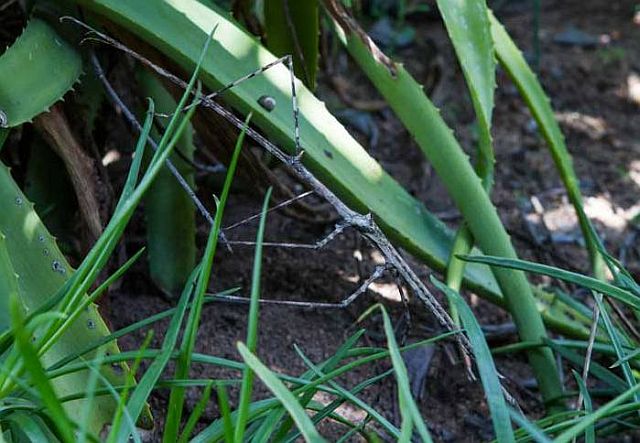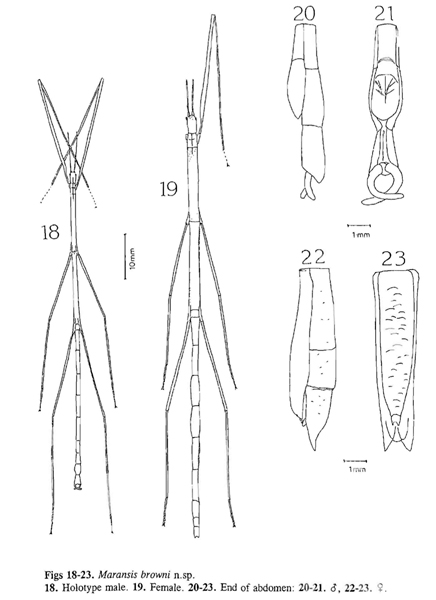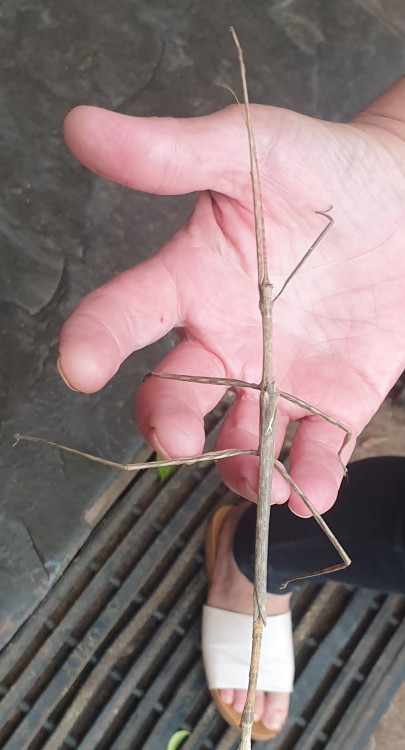AW Insect Book: Stick Insects (Order Phasmida/Phasmatodea)
Upload your picture of a stick insect and add a description underneath. Please only do one species per post.
All entries will be edited and updated (additional photos and information will be added by moderators). New entries will be posted according to taxonomic order and the post date does not reflect the actual date of new posts.
AW Insect Book: Stick Insects - Photos & Descriptions
Moderator: Klipspringer
Index to Stick Insects (Phasmatodea/Phasmida)
Stick Insects (Phasmatodea/Phasmida) - Index

Suborder: ANAREOLATAE
Diapheromeridae
Bactrododema krugeri Giant Stick Insect
Bactrododema tiaratum Giant Stick Insect
Lonchodinae
Pachymorphinae
Maransis brownii Stick Insect
Palophinae
Suborder: AREOLATAE
Bacillidae
Bacillinae
Phalces brevis Cape Stick Insect
Antongiliinae
Macyniinae

Suborder: ANAREOLATAE
Diapheromeridae
Bactrododema krugeri Giant Stick Insect
Bactrododema tiaratum Giant Stick Insect
Lonchodinae
Pachymorphinae
Maransis brownii Stick Insect
Palophinae
Suborder: AREOLATAE
Bacillidae
Bacillinae
Phalces brevis Cape Stick Insect
Antongiliinae
Macyniinae
AW Insect Book: Stick Insects - Photos & Descriptions
Giant Stick Insect Bactrododema krugeri
Family: Diapheromeridae. Subfamily: Palophinae. Tribe: Palophini
This was an amazing sighting, in the thatch of one of the huts at Croc Bridge! This is without doubt the largest insect I have ever seen by quite a margin, I estimate that it was around 30 cm long
 © BluTuna
© BluTuna
Crocodile Bridge, Kruger National Park
 © Pumbaa
© Pumbaa
Kruger National Park
Description
A very large stick insect with wings in males and long horns (up to 7 mm long). With a body length of 163 mm or 295 mm taking outstretched legs into account (males) and between 193 mm and 226 mm for females, this stick insect is the longest species in South Africa.
Femora with subapical lobes and broad sub-basal foliose lobes.
Distribution
Botswana, South Africa: Gauteng, Mpumalanga, Limpopo Province.
Note: In the Kruger National Park are only two species of Bactrododema found: B. krugeri and the smaller B. tiaratum.
Links: The Diapheromerid Stick Insects (Phasmida: Diapheromeridae) of South Africa; Phasmida Speciesfile; Meet SA's longest stick insect - almost the length of a 30cm ruler
https://www.researchgate.net/publicatio ... ma_species
Family: Diapheromeridae. Subfamily: Palophinae. Tribe: Palophini
This was an amazing sighting, in the thatch of one of the huts at Croc Bridge! This is without doubt the largest insect I have ever seen by quite a margin, I estimate that it was around 30 cm long
 © BluTuna
© BluTunaCrocodile Bridge, Kruger National Park
 © Pumbaa
© PumbaaKruger National Park
Description
A very large stick insect with wings in males and long horns (up to 7 mm long). With a body length of 163 mm or 295 mm taking outstretched legs into account (males) and between 193 mm and 226 mm for females, this stick insect is the longest species in South Africa.
Femora with subapical lobes and broad sub-basal foliose lobes.
Distribution
Botswana, South Africa: Gauteng, Mpumalanga, Limpopo Province.
Note: In the Kruger National Park are only two species of Bactrododema found: B. krugeri and the smaller B. tiaratum.
Links: The Diapheromerid Stick Insects (Phasmida: Diapheromeridae) of South Africa; Phasmida Speciesfile; Meet SA's longest stick insect - almost the length of a 30cm ruler
https://www.researchgate.net/publicatio ... ma_species
Hunting cannot be considered a sport as all contestants in a sport should know they are playing the game!
Re: AW Insect Book: Stick Insects - Photos & Descriptions
Walking Stick, Stick Insect Maransis browni
Family: Diapheromeridae Subfamily: Pachymorphinae Tribe: Gratidiini


KTP female
Description
Male (Holotype - original description of the species based on a single individual)
*Medium sized, uniform yellowish brown with bold longitudinal central black stripe from head to front of mesonotum. Body length 70 mm
*Head elongate, longer than wide, smooth. Eyes dark blackish brown. Black central stripe and two lateral lines present. Antennae short, less than half length of femora, with 19 segments. Basal segment broader, second segment reduced in length.
*Thorax elongate, smooth. Pronotum slightly shorter than head, with a bold black central stripe. Clear central indentation. Mesonotum more than 5.5 times length of pronotum towards end; also with shorter lateral black lines. These lines also present at hind part of segment. Metanotum longer than mesonotum, with black central and lateral lines present at start and hind part of segment. Median segment short.
*Abdomen elongate, smooth. Segments of similar length until shorter, swollen 8th segment. Ninth segment longer than 8th and very swollen, narrowing towards anal segment. Anal segment sharply broadened towards tip, hind margin double lobed. Cerci long, incurved, rounded at tip. Subgenital plate broad and swollen, end not quite rounded, almost reaching end of 9th abd. segment.
*Legs plain, elongate.
Female (Paratype - additional specimens representative of the species)
*Medium sized, uniform yellowish brown with bold black stripe from pronotum to front of mesonotum. Numerous small tubercles laterally on mesonotum, rather smaller on metanotum. Body length 93 mm.
*Head as in male, but lacks black central stripe.
*Thorax as in male except mesonotum 5 times length of pronotum. Black central line continuing for 1.5 mm. Dorsal surface of mesonotum, apart from the tubercles, sparsely granulated, particularly on upper part. Metanotum also with series of granulations laterally; longer than mesonotum.
*Abdomen with segments of similar length until shorter 8th segment, slightly swollen, then tapering to much shorter 9th segment. Anal segment slightly longer than 9th, almost triangular incised, giving the appearance of a double pointed tip. Operculum elongate, end sub truncate, not reaching half the length of anal segment. Cerci of moderate length, concealed beneath anal segment.
*Legs as in male.

Distribution
So far only known from the type locality near Kuruman in Northern Cape Province
http://phasmidstudygroup.org/files/Phas ... s1and2.pdf
Family: Diapheromeridae Subfamily: Pachymorphinae Tribe: Gratidiini


KTP female
Description
Male (Holotype - original description of the species based on a single individual)
*Medium sized, uniform yellowish brown with bold longitudinal central black stripe from head to front of mesonotum. Body length 70 mm
*Head elongate, longer than wide, smooth. Eyes dark blackish brown. Black central stripe and two lateral lines present. Antennae short, less than half length of femora, with 19 segments. Basal segment broader, second segment reduced in length.
*Thorax elongate, smooth. Pronotum slightly shorter than head, with a bold black central stripe. Clear central indentation. Mesonotum more than 5.5 times length of pronotum towards end; also with shorter lateral black lines. These lines also present at hind part of segment. Metanotum longer than mesonotum, with black central and lateral lines present at start and hind part of segment. Median segment short.
*Abdomen elongate, smooth. Segments of similar length until shorter, swollen 8th segment. Ninth segment longer than 8th and very swollen, narrowing towards anal segment. Anal segment sharply broadened towards tip, hind margin double lobed. Cerci long, incurved, rounded at tip. Subgenital plate broad and swollen, end not quite rounded, almost reaching end of 9th abd. segment.
*Legs plain, elongate.
Female (Paratype - additional specimens representative of the species)
*Medium sized, uniform yellowish brown with bold black stripe from pronotum to front of mesonotum. Numerous small tubercles laterally on mesonotum, rather smaller on metanotum. Body length 93 mm.
*Head as in male, but lacks black central stripe.
*Thorax as in male except mesonotum 5 times length of pronotum. Black central line continuing for 1.5 mm. Dorsal surface of mesonotum, apart from the tubercles, sparsely granulated, particularly on upper part. Metanotum also with series of granulations laterally; longer than mesonotum.
*Abdomen with segments of similar length until shorter 8th segment, slightly swollen, then tapering to much shorter 9th segment. Anal segment slightly longer than 9th, almost triangular incised, giving the appearance of a double pointed tip. Operculum elongate, end sub truncate, not reaching half the length of anal segment. Cerci of moderate length, concealed beneath anal segment.
*Legs as in male.

Distribution
So far only known from the type locality near Kuruman in Northern Cape Province
http://phasmidstudygroup.org/files/Phas ... s1and2.pdf
Last edited by ExFmem on Mon Apr 26, 2021 7:55 pm, edited 1 time in total.
Re: AW Insect Book: Stick Insects - Photos & Descriptions
Cape Stick Insect Phalces brevis
Family: Bacillidae. Subfamily: Bacillinae. Tribe: Phalcini
 © steamtrainfan
© steamtrainfan
Addo Elephant National Park, Spekboom hide
Description
Medium-sized: male 50-55 mm, female 70-80 mm. Very stick-like, wingless insects with short antennae; colour varibale. The male is greenish brown, with three blue or green marks and white bands on the pronotum, hind part of the mesonotum and metanotum. Legs often a different colour from body, green with a brown base and apical band on all femora. The cerci are whitish. Females are usually brown, grey or green, perhaps speckled. The abdomen ends in a boat-shaped chute-like appendage, which varies in length. However, it is often around four times the length of the anal (last abdominal) segment.
Distribution
Western Cape, Eastern Cape, KwaZulu-Natal.
Biology
Females drop their glossy eggs to the ground. The resulting nymphs moult five times, taking about 4-6 months to mature; adults live 4-6 months. Each female usually lays a few hundred eggs. Adults remain well concealed in the daytime, often moving away from their foodplants, only to return at night.
When disturbed, nymphs may sway from side to side. Bisexual reproduction is by means of a spermatophore (sperm sac), although they can reproduce parthenogenetically. Certain ants are attracted to eggs, which they carry to their nest by the capitulum (knob on the lid of the egg). The capitulum is removed and eaten without reducing egg viability.
Links: The Bacillid Stick Insects of South Africa; Phasmida Speciesfile
Family: Bacillidae. Subfamily: Bacillinae. Tribe: Phalcini
 © steamtrainfan
© steamtrainfanAddo Elephant National Park, Spekboom hide
Description
Medium-sized: male 50-55 mm, female 70-80 mm. Very stick-like, wingless insects with short antennae; colour varibale. The male is greenish brown, with three blue or green marks and white bands on the pronotum, hind part of the mesonotum and metanotum. Legs often a different colour from body, green with a brown base and apical band on all femora. The cerci are whitish. Females are usually brown, grey or green, perhaps speckled. The abdomen ends in a boat-shaped chute-like appendage, which varies in length. However, it is often around four times the length of the anal (last abdominal) segment.
Distribution
Western Cape, Eastern Cape, KwaZulu-Natal.
Biology
Females drop their glossy eggs to the ground. The resulting nymphs moult five times, taking about 4-6 months to mature; adults live 4-6 months. Each female usually lays a few hundred eggs. Adults remain well concealed in the daytime, often moving away from their foodplants, only to return at night.
When disturbed, nymphs may sway from side to side. Bisexual reproduction is by means of a spermatophore (sperm sac), although they can reproduce parthenogenetically. Certain ants are attracted to eggs, which they carry to their nest by the capitulum (knob on the lid of the egg). The capitulum is removed and eaten without reducing egg viability.
Links: The Bacillid Stick Insects of South Africa; Phasmida Speciesfile
-
Klipspringer
- Global Moderator
- Posts: 5858
- Joined: Sat Sep 14, 2013 12:34 pm
- Country: Germany
- Contact:
Re: AW Insect Book: Stick Insects - Photos & Descriptions
Giant Stick Insect Bactrododema tiaratum
Family Diapheromeridae. Subfamily Palophinae. Tribe Palophini


Satara, Kruger National Park © mposthumus
Description
Head with a pair of short horns. Elongate.
Mesonotum with a pair of central spines (sometimes absent, or in extreme cases, with several spines).
Body length 125–185 mm.
Distribution
Botswana, Namibia, South Africa, eSwatini and Zimbabwe.
Biology
Nymphs and adults feed on Acacia species (Mimosaceae/Leguminosae).
Nymphs resemble miniature versions of adults and gradually develop wings. Adults have been collected throughout the year, but mainly from November to March.
Links:
https://www.researchgate.net/publicatio ... e/download
http://phasmida.speciesfile.org/Common/ ... ID=1203831
Family Diapheromeridae. Subfamily Palophinae. Tribe Palophini
Satara, Kruger National Park © mposthumus
Description
Head with a pair of short horns. Elongate.
Mesonotum with a pair of central spines (sometimes absent, or in extreme cases, with several spines).
Body length 125–185 mm.
Distribution
Botswana, Namibia, South Africa, eSwatini and Zimbabwe.
Biology
Nymphs and adults feed on Acacia species (Mimosaceae/Leguminosae).
Nymphs resemble miniature versions of adults and gradually develop wings. Adults have been collected throughout the year, but mainly from November to March.
Links:
https://www.researchgate.net/publicatio ... e/download
http://phasmida.speciesfile.org/Common/ ... ID=1203831


